Typhoon Haiyan. The strongest storm ever recorded at landfall. This photo essay captures a moment in time some weeks after the typhoon. It documents survivors of the exceptionally powerful tropical cyclone. Haiyan, or Yolanda as known locally, was a Category 5 Super Typhoon that struck the region on November 8, 2013. Wind speeds of 230 km/hour and gusts of up to 315 km/hour caused damage beyond comprehension, on an unparalleled scale. A death toll of more than 6,000, and over 11 million affected. The storm surge was forecast, but people didn’t understand what it meant, and this was a contributing factor to a great number of the deaths, most by drowning.
Photo Essays | Society | Southeast Asia
Philippines: Typhoon Haiyan Aftermath Part II
Images from the early stages of the aftermath of the devastating typhoon.
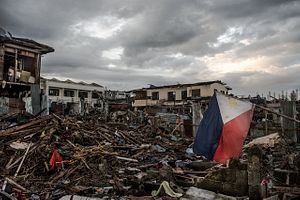
Three weeks after the typhoon and the national flag of the Philippines, a macabre marker, is being used by local people to identify the location of an uncollected corpse. Previously a gloriously beautiful spot, this area, Barangay 48B was the site of the first original settlement in Tacloban. Prior to the typhoon there were 104 homes in this pretty historic Barangay, about 500 people living by the sea. The death toll for this community is 40 and counting. To add to the tragedy, building of houses 40 meters from the shorelines is now prohibited following the passage by the City Council here of a “no-build zone” ordinance, in December 2013, leaving this unfortunate community unable to re-build their simple homes in the same place. Bunkhouses or temporary shelters that are being constructed by the Department of Public Works and Highways may be one solution, certainly not a desirable option for most.
Credit: Piyavit Thongsa-Ard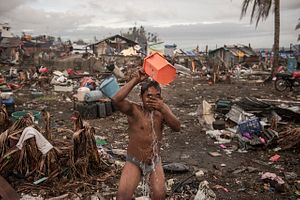
This man’s home was right the shore of the port area of hard hit Tacloban, which was directly in the path of Haiyan. Weeks later and people are struggling to live. Extreme infrastructure damage, coupled with collapse in sanitation, shortages of fresh water, limited water and food, and the great concern is serious illness and potentially fatal diseases. The long list of illnesses includes cholera, hepatitis, malaria, dengue fever, typhoid fever, and bacterial dysentery. The fear is leptospirosis, a parasite endemic to the Philippines, and a return of polio. The World Health Organisation declared this country polio free at the end of the 1990s. Tetanus infections are also expected to be widespread, as so many survivors are being injured, as they clear the debris. Little by little small progress is being made to create shelter, by scavenging from the detritus, a piece of bent rusted metal here, a small piece of wood there, collect enough and once again there will be a place to call home.
Credit: Piyavit Thongsa-Ard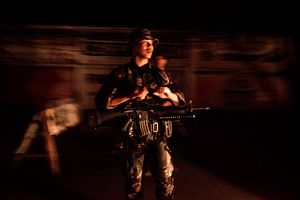
Military personal at one of the many checkpoints in and around Tacloban City to enforce the dawn-to-dusk curfew. Policeman, military and government forces are all stationed to prevent further looting of the commercial areas and yung mga stores, which had already suffered huge losses from pillaging. Survivors of the typhoon had been left desperate, starving with no food, water, or medical supplies. Aid convoys were also looters. Local people, whose more substantial homes were mercifully left intact, were now very fearful of dangerous groups of thieves who were climbing onto roof-tops, and trying to rob their homes. Up to 600 escaped convicts were on the loose after they managed to break down a provincial jail wall. Talk of attacks on women and girls by anti-government rebels also fuelled the fear. Many small businesses were affected by robberies, and for the Tacloban community, it was an extra blow.
Credit: Piyavit Thongsa-Ard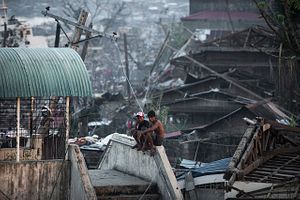
Thousands of families were left homeless; here youths sit on the stairs of the sturdy concrete bridge surveying the horror of the destroyed port area, north of downtown. The air is filled with the stench of rotting bodies, which lie trapped, in, under, and amongst the twisted, mangled debris, waiting to be found, and removed. The electricity supply has not been spared by the typhoon, diesel fuel is rare, and expensive, vehicles almost non-existent, meaning that the only light, and heat for cooking will come from small fires built outside of every home. Much of the food aid given is uncooked rice, and given to individual families. From sunrise to dusk exhausted and traumatized families attack these mountains of rubbish from the street, trying to make some clean space around what’s left of their homes. At nightfall the fires are lit, the air quickly becomes thick with toxic black smoke, as these fishing communities cook their meager rations of rice, and tinned pilchards.
Credit: Piyavit Thongsa-Ard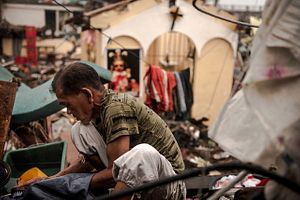
Crouching over a plastic bowl, in front of the ruin of a small Roman Catholic Church, this gentleman scrubs his clothes, trying to get them clean again, after weeks with little water. Survivors face many challenges just to get simple things done. For as far as the eye can see, there is total chaos. All over Leyte Province, hundreds of thousands of people are doing the same thing, collecting up what they can find that’s been spared by the immense storm, and cleaning. Anything that can be used as a washing-line is bought into commission, including power-lines that hang precariously between the broken buildings. Most people were taken by surprise, and their precious stockpiles of food, water, candles, medicines and emergency supplies were blasted away from homes as the waters rose, meters in seconds, in fierce winds and zero visibility.
Credit: Piyavit Thongsa-Ard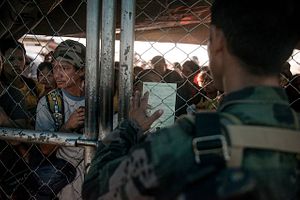
Exodus at Tacloban Airport. Thankfully the control tower survived Haiyan’s extreme winds. Thousands of distraught, traumatized people queue desperate to leave the city. Philippine soldiers face the crowds, on the other side of the wire fence. Two weeks after the typhoon and few military relief planes are able to land at Tacloban, due to limited runway space. Stress levels are high amongst workers in uniforms, many of whom have themselves lost or are missing family, friends and colleagues in the typhoon, and they are struggling to cope, physically and mentally drained.
Credit: Piyavit Thongsa-Ard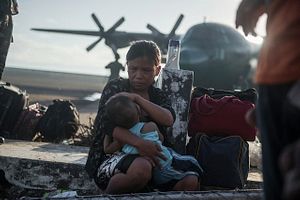
All of the horror and suffering is reflected in this mother’s face, as she tenderly nurses her child. Apocalyptic scenes around her, and now she waits at Tacloban’s Daniel Z Romualdez Airport, sitting patiently on the concrete to be called for a C130 military flight to safety. Weeks after the typhoon and still there are problems with logistics at the airport, with few C130 relief planes are able to land here, due to limited runway space. The extreme damage caused to the airport, restricts the number of flights. Urgently needed relief goods and aid into Tacloban is jeopardized by smaller commercial jets, whose seats are being bought by those lucky enough to have $40, or $60 to buy their way out of the horror.
Credit: Piyavit Thongsa-Ard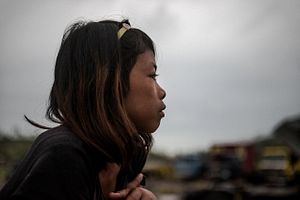
Of the 14 million people believed to be affected, 1.8 million are children. The Philippines is predominately a Catholic country and families are large. Now these children are traumatized, having survived the horror of the typhoon, they face an uncertain future, with a lack of food, and vulnerable to illegal adoptions and sexual exploitation through trafficking. Whilst many typhoon orphans are especially at risk, there are many cases where the parents are involved, working directly with pedophile rings on the internet. The traffickers will often claim to be saving the children, and sell them as “brides.” A huge region affected, and the physical geography of the country, with 7,000 islands makes it very difficult to monitor, control or stem this flow.
Credit: Piyavit Thongsa-Ard































